Our Response to Climate Change Risks and Opportunities (TCFD)
Basic Approach
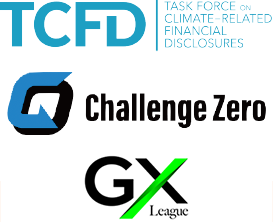
As an energy and materials company group, the ENEOS Group recognizes that its response to climate change involves both material management risks and opportunities. We believe that developing practical solutions to climate change will enable us to continuously generate profits into the future. As a clear expression of this intent, in our Long-Term Vision we state that we will take on the challenge of achieving both a stable supply of energy and materials and the realization of a carbon-neutral society.
Specifically, we aim to reduce our own greenhouse gas emissions (Scope 1+2) by 46% by fiscal 2030 compared to fiscal 2013 and achieve carbon neutrality by fiscal 2040. In order to achieve carbon neutrality, including Scope 3 emissions, by fiscal 2050, we will pursue energy transitions through energy saving at our refineries, plants, and smelters, and in the energy field, we will expand the use of renewable energy and work toward the early practical implementation of hydrogen and carbon-neutral fuels. In the materials and services field, we will pursue the development of a circular economy through efforts such as the conversion of raw materials and sharing services to increase the amount of avoided emissions.
To enhance and broaden its disclosures, the Company signed a statement of support for the recommendations of the Task Force on Climate-related Financial Disclosures (TCFD) in May 2019. The Company also endorsed the Challenge Zero initiative of the Japan Business Federation (Keidanren) in June 2020, and is working on the development of technologies to mitigate the impacts of climate change.
Additionally, with an eye on the realization of carbon neutrality by 2050 and social transformation, the Company participates in the Green Transformation (GX) League and actively makes recommendations for the design of the emissions trading scheme (GX-ETS). The GX League, a framework based on the basic concept of the Ministry of Economy, Trade and Industry (METI), was established as a forum for companies aiming to achieve sustainable growth in the present and future to collaborate with government and academia.
Overview of TCFD Disclosure Recommendations
| Governance | Disclose the organization’s governance around climate-related risks and opportunities. | Supplemental information | References |
|---|---|---|---|
| a Describe the board’s oversight of climate-related risks and opportunities. | Incorporating climate change risks and opportunities into management strategies | ||
| b Describe management’s role in assessing and managing climate change-related risks and opportunities. | Senior management manages the progress of management strategies | ||
| Strategy | Disclose the actual and potential impacts of climate-related risks and opportunities on the organization’s businesses, strategy, and financial planning where such information is material. | Supplemental information | References |
| a Describe the climate-related risks and opportunities the organization has identified over the short, medium, and long term. | Identification of transition risks, opportunities, and physical risks, clarification of the time horizon, disclosure of quantitative impacts, and reflection of them in management strategies | ||
| b Describe the impact of climate-related risks and opportunities on the organization’s businesses, strategy, and financial planning. | |||
| c Describe the resilience of the organization’s strategy, taking into consideration different climate-related scenarios, including a 2°C or lower scenario. | Consideration of multiple scenarios, including 2°C or lower, when formulating strategies | ||
| Risk Management | Disclose how the organization identifies, assesses, and manages climate-related risks. | Supplemental information | References |
| a Describe the organization’s processes for identifying and assessing climate-related risks. | Use of enterprise risk management (ERM) to identify and evaluate risks and opportunities, incorporate them into management strategies, and manage progress | ||
| b Describe the organization’s processes for managing climate-related risks. | |||
| c Describe how processes for identifying, assessing, and managing climate-related risks are integrated into the organization’s overall risk management. | |||
| Metrics and Targets | Disclose the metrics and targets used to assess and manage relevant climate-related risks and opportunities where such information is material. | Supplemental information | References |
| a Disclose the metrics used by the organization to assess climate-related risks and opportunities in line with its strategy and risk management process. | Evaluation using the degree of impact and probability of occurrence as indicators | ||
| b Disclose Scope 1, Scope 2, and, if appropriate, Scope 3 greenhouse gas (GHG) emissions and the related risks. | Disclosure of Scope 1, 2 and 3 GHG emissions | ||
| c Describe the targets used by the organization to manage climate-related risks and opportunities and performance against targets. | Disclosure of basic plan | ||
Governance System for Climate Change
In 2024, the Group established the Carbon Neutrality Promotion Committee, led by the CTO, to update basic strategies in response to changes in the business environment. The basic strategies discussed by the Carbon Neutrality Promotion Committee will be reflected in future medium-term management plans and other management strategies. The medium-term management plan and other management strategies are discussed by the ENEOS Holdings Executive Council, chaired by the ENEOS Holdings CEO, which deliberates on the Group’s response to climate change, including in future business plans, and manages and evaluates the status of climate initiatives from a cross-functional perspective. The council reports the results of its deliberations, management, and evaluation to the ENEOS Holdings Board of Directors, which also monitors and supervises the council.
Deliberations in Fiscal 2023
Board of Directors and Executive Council
- Results of ESG activities in fiscal 2022 and identification of material ESG issues in fiscal 2024
- Formulation of the Carbon Neutrality Plan
- Status report on carbon neutrality strategies
Response to Climate Change and Link to Executive Remuneration
Remuneration for the Company’s directors consists of a monthly remuneration in accordance with role, performance-linked bonuses, and share-based remuneration. The performance indicators on which share-based remuneration is based include greenhouse gas emissions reduction, along with operating profit excluding inventory valuation, ROE, and other financial indicators.
The inclusion of greenhouse gas emissions reduction reflects our commitment to reducing emissions and functions as an incentive for forming and implementing highly competitive business strategies from a medium- to long-term perspective.
Scenario Analysis
The Group conducted scenario analysis for the review of its Long-Term Vision. In conducting the analysis, we referenced STEPS1, APS2, and NZE3 of World Energy Outlook (WEO) 2022 by the IEA for long-term forecasts of world energy demand, and Representative Concentration Pathways (RCP4) of the IPCC for the assessment of physical risks such as changes in climate and sea levels. This resulted in the identification of risks and opportunities (see table below: Financial Impacts of Climate Change-Related Risks and Opportunities).
In revising our Long-Term Vision announced in 2019, we referenced multiple WEO scenarios, using the middle ground among them as the Group’s base case. As a result, although the overarching direction of the social scenario in our Long-Term Vision will remain the same as the one in 2019, we believe uncertainty regarding this change toward decarbonization is greater than anticipated.
In the base-case scenario, risks include a decline in domestic fuel oil demand by around half in 2040 compared to 2019, while opportunities include the growth of the market for energy derived from decarbonized and recyclable resources and the generalization of environmental value trading. Additionally, demand is expected to grow for high-value-added services in mobility, such as EVs and car sharing, and lifestyle support for making life more convenient, as well as recycled resources, along with high-performance and advanced materials required for digital devices.
During the transition from fossil fuels to a portfolio centered on decarbonization, the Group will achieve both a stable supply of energy and the realization of a carbon-neutral society while keeping close watch over demand trends for fuel oil. The Group is maintaining its high degree of resilience in responding to multiple scenarios as it has a number of advantages that enable it to withstand change and is carrying out investments and demonstration projects, as well as verifying scenarios annually in accordance with the external and internal environments surrounding the Group5.
- 1Stated Policies Scenario: A scenario that reflects government policies already announced
- 2Announced Pledges Scenario: A scenario that assumes that countries will achieve their ambitious targets
- 3Net Zero Emissions by 2050 Scenario: A scenario in which the world will achieve net zero in 2050
- 4Representative Concentration Pathways: A scenario on rising temperatures based on a greenhouse gas concentration trajectory
- 5Implemented by the Carbon Neutrality Promotion Committee, established in May 2024
Changes in Business Environment

Financial Impacts of Climate Change-Related Risks and Opportunities
We have developed and operate an enterprise risk management (ERM) system to identify and analyze Group management risks and ensure appropriate responses. Based on this process, we recognize that our response to climate change involves both material management risks and opportunities, which we have identified as shown in the table below.
We estimate financial impacts based on our own base scenario for transition risks and the IPCC RCP8.5 scenario* as the stress case for physical risks. These estimates include many potential risks, uncertainties, and assumptions, and changes in material factors may lead to significantly different outcomes.
- *Intergovernmental Panel on Climate Change (IPCC) assessment scenario, in which the global average temperature rises by about 4°C by 2100 compared to the period from 1986 to 2005
Financial Impacts of Climate Change-Related Risks and Opportunities
| Category | Financial impact | ||||
|---|---|---|---|---|---|
| Short term (2025) |
Medium term (2030) |
Long term (2040) |
Assessment method | ||
| Transition risks |
|
None | ¥30 billion annually | ¥120 billion annually | Amount of decline in operating profit if carbon credits were purchased for the entire reduction targets for 2030 and 2040 of 4 million tons and 19 million tons, respectively Carbon credit price ($50/t-CO21) × quantity × exchange rate
|
|
Limited impacts | Approx. ¥50 billion/year decline | Approx. ¥100 billion/year decline | Amount of decline in operating profit if domestic petroleum demand declined by approx. 20% in 2030 and approx. 50% in 2040 compared to 2019 (Calculated based on the fiscal 2025 income targets of the third Medium-Term Management Plan) |
|
|
Limited risk | Estimation of oil upstream asset reserves based on the number of extractable years discounted by current production | |||
| Physical risks |
|
¥100 to ¥200 million/year | Referenced the IPCC RCP8.5 scenario for estimation of the total amount of damage (decrease in operating profit) using WRI Aqueduct2, etc. for 31 of our facilities and assets in Japan, such as refineries and smelters
|
||
|
Limited risk | Estimated from amount of increase (approx. 0.2 meters) in sea level around Japan as of 2040 as projected by Aqueduct | |||
| Opportunities |
|
Careful planning and rollout phase | Up to ¥50 billion/year | Up to ¥200 billion/year | Profit estimated based on certain assumptions about the estimated market size, the Company’s market share, and operating profit margin due to an expected increase in demand for renewable energy, hydrogen, and carbon-neutral fuels associated with advancements toward a decarbonized, recycling-oriented society |
|
Careful planning and rollout phase | Up to ¥50 billion/year | Up to ¥100 billion/year | Profit estimated based on certain assumptions about the estimated market size, the Company’s market share, and operating profit margin due to an increase in demand for EV charging, which is expected to grow with the development of a decarbonized society, and an expansion of business opportunities such as environmentally friendly mobility services | |
|
¥100 billion/year | Up to ¥150 billion/year | Up to ¥200 billion/year | Profit estimated based on certain assumptions about the estimated market size, the Company’s market share, and the operating profit margin due to the expected increase in demand for products that contribute to the reduction of greenhouse gas emissions and the expected increase in demand for materials derived from recyclable resources for a circular economy | |
- Note:
- The above was developed in May 2023. It will be reviewed as appropriate in accordance with changes in various conditions surrounding the economy and the formulation of our medium- to long-term business strategies.
Assessment of Physical Risks
In assessing physical risks, we examined the risks from the objective perspective of Sompo Risk Management Inc., an external expert, referring to the IPCC RCP scenario. For the scenarios, we have adopted RCP8.5 (equivalent to a 4°C increase) as a stress case, and RCP4.5 (equivalent to STEPS in IEA WEO) and RCP2.6 (equivalent to APS) as cases that are close to our base-case scenario. As a result of simulating the amount of damage caused by flooding using WRI Aqueduct and other means for 31 of our facilities and assets in Japan, such as refineries and smelters, our current estimate of the average annual amount of damage in the stress case is over 100 million yen, and we expect the average annual amount of damage to be about 100 million to 200 million yen in 2040.
There is a tendency for damage to be greater in locations where storm surges are a concern due to large rivers in the vicinity or strong winds during the passage of typhoons. We are implementing measures to mitigate these risks to ensure that the overall impact is minimal.
Expected Annual Amount of Damage Due to Inland Flooding
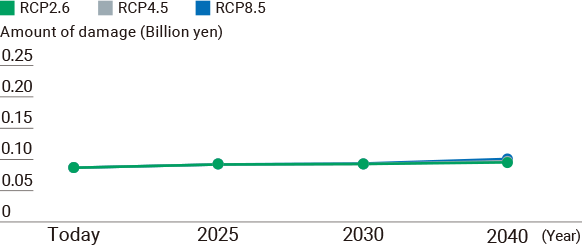
Expected Annual Amount of Damage Due to Coastal Flooding
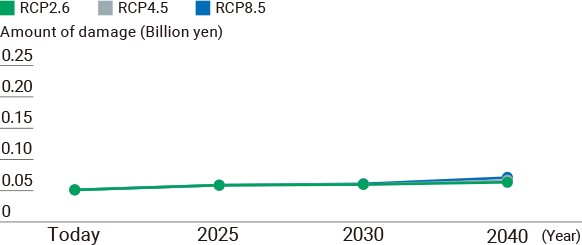
Building a Business Portfolio That Addresses Risks and Opportunities
While it is certain that society will move toward carbon neutrality based on international trends and other factors, it remains unclear what the main source of carbon-neutral energy will be and when necessary technological breakthroughs will occur. Taking into account policy trends and other factors, we believe that the turning point will be around 2030. We have a high level of resilience that enables us to respond to any scenario, and we will continue working to establish our technological and strategic superiority toward the turning point, which will be around 2030.
We will make the necessary investments ahead of this turning point in 2030. We will focus on the development of intangible assets not booked on the balance sheet, such as technological development, collaboration with leading partners, utilization of support systems from the government, and human resources development.
Meanwhile, we will also streamline and improve the efficiency of our existing fossil-resource-derived energy businesses in line with the decline in demand in the domestic market. We will secure and develop human resources and other intangible assets during the third Medium-Term Management Plan to establish our advantage as a pioneer. We will also monitor the growth of the decarbonization market and expand capital investment in promising fields from 2030 onward. In terms of the scale of capital to be invested, we plan to increase the total amount by 1.3 times compared to fiscal 2025 by 2040.
Currently, fossil energy accounts for more than half of the Group’s earnings. Under the third Medium-Term Management Plan, we will implement various measures following the basic policies of “establish a solid earnings base,” “accelerate execution of measures for energy transition,” and “enhance the management base,” to maximize earnings in our current business portfolio.
At the same time, by 2030, in addition to upfront investment in decarbonization, we will build a business foundation for EV charging and the ENEOS Platform to meet the needs of local communities and individuals. By around 2040, the “permeation” phase of the energy transition, we expect our earnings portfolio to comprise 50% decarbonized energy and fossil energy offset by CCS and other measures, and 50% materials and the ENEOS Platform.
Scale of Investment Capital and Profits in the Long-Term Vision by Business Area
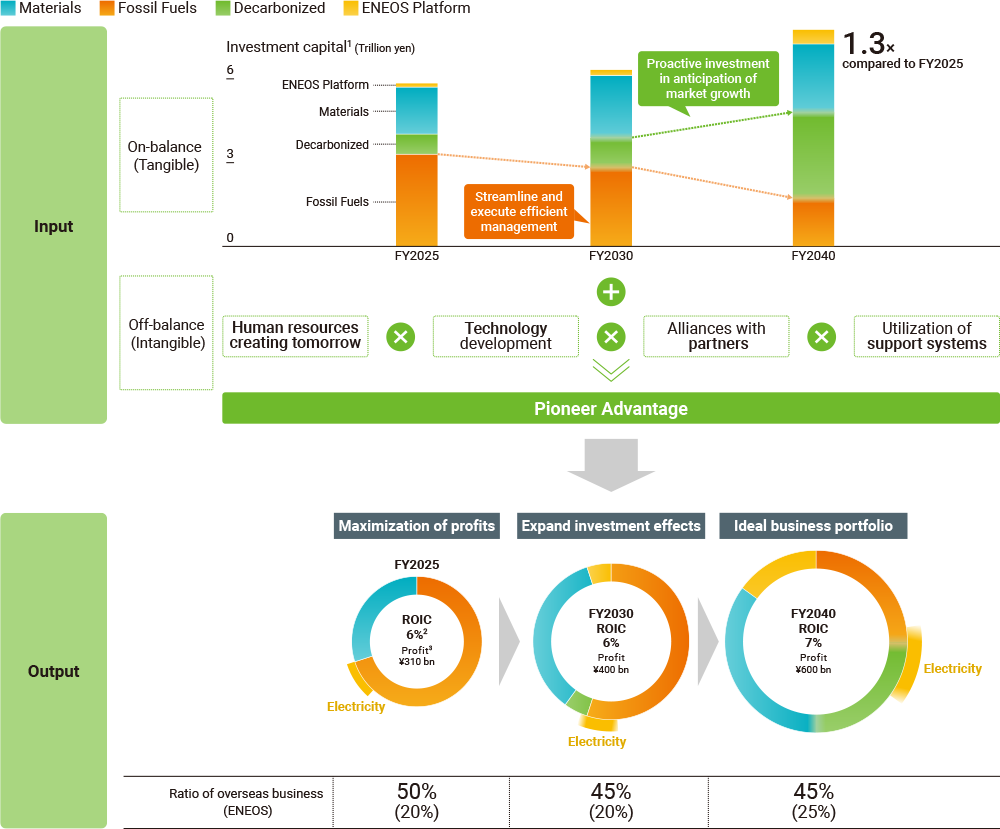
- 1Fixed asset balance by business + working capital of inventory, etc.
- 2Including incubation businesses. The target for FY2025 is 7% or higher excluding the incubation businesses.
- 3Profit attributable to owners of the parent
Internal Carbon Pricing System
We are advancing our shift to being a business that contributes to the reduction of carbon emissions by setting an internal carbon price of 50 dollars per ton* as a reference and identifying the impacts of both the risks and opportunities associated with changes in our CO2 emissions. We have set specific CO2 reduction values with the aim of accelerating the construction of a business portfolio that will enable us to achieve carbon neutrality. We will use these values as factors to guide investments in energy efficiency that will lower our carbon emissions and to encourage exploration of new investments that will advance our conversion to decarbonized energy. The internal carbon price will be updated as the business environment evolves.
- *For ENEOS and ENEOS Xplora business areas
Realizing a Just Transition
In building our business portfolio for a decarbonized society, we believe that reducing social and economic burdens is essential to the continuity of social and economic activity during the transition period. The most effective way we can contribute to a just transition is by fully leveraging our strengths, including our refineries, supply chain and other existing assets, our highly professional and motivated human capital, and our close relationships with local communities, including local economies.
For example, in building a hydrogen supply chain, which is currently in progress, we can use our refineries, logistics, and service station network to establish a competitive advantage, which will enable us to minimize any adverse impacts on our employees or related companies as well as on the employment and labor conditions and people’s livelihoods in local communities.
Our approach is aligned with the International Labour Organization’s “Guidelines for a just transition towards environmentally sustainable economies and societies for all.”
We also conduct human rights due diligence based on the United Nations Guiding Principles on Business and Human Rights every two years, and we will carry out regular reviews and implement appropriate measures as we pursue our initiatives during the transition.
Indicators and Targets
In its Carbon Neutrality Plan, the Group has set targets to achieve net zero emissions for Scope 1+2 greenhouse gases by fiscal 2040. In addition, working in step with the government and other companies, we aim to contribute to the realization of a carbon-neutral society by 2050.
We have set interim targets for 2025 and 2030 for our own emissions, and for 2025, 2030, and 2040 for the portion that includes Scope 3.
In setting these targets, we considered multiple scenarios, including those that align with the 1.5°C target in the Paris Agreement.
For information on our results for reduction in GHG emissions, see Prevention of Global Warming.
Roadmap for Reduction of ENEOS Group Greenhouse Gas Emissions
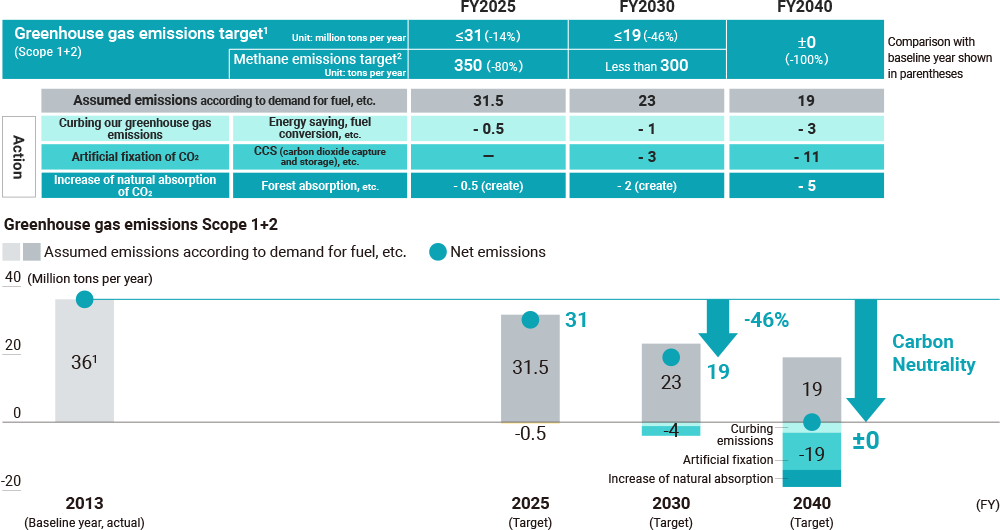
- 1Greenhouse gas emissions in the base year (fiscal 2013): 36 million tons. Figure revised from the time of announcement in May 2022 (30 million tons) due to a change in the calculation method for domestic emissions from the standard under the Act on Promotion of Global Warming Countermeasures to the GX-ETS standard. There is no change to the target for transition-linked bonds (issued on June 15, 2022), but the greenhouse gas emission target for fiscal 2030 has been changed from 16 million tons to 19 million tons.
- 2Methane emissions in base year (fiscal 2021): 1,600 tons
Roadmap for the Reduction of Greenhouse Gas Emissions of Society
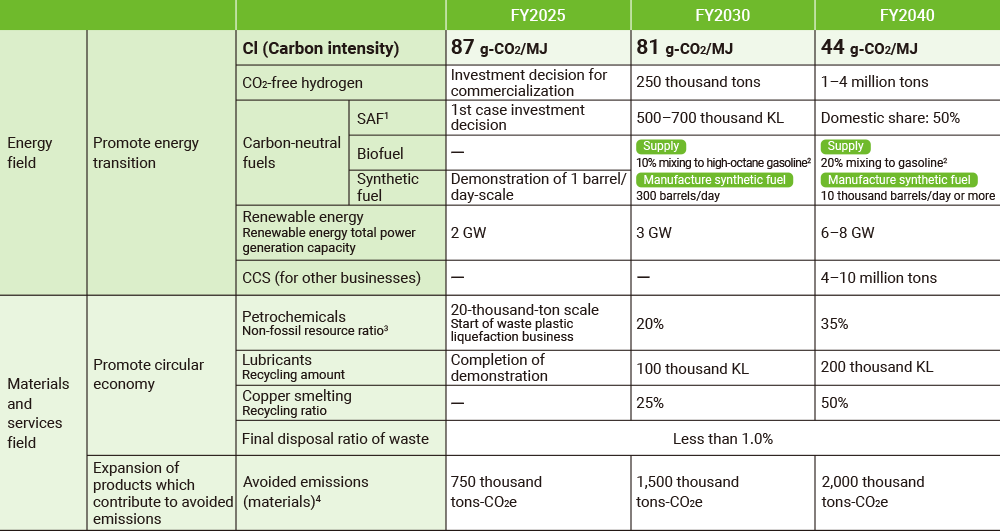
- 1Sustainable aviation fuel, a low-carbon aviation fuel made from biomass, waste, and waste oil
- 2Biofuel + synthetic fuel
- 3Input ratio of green raw materials (waste-plastic-recycled oil, bionaphtha, etc.) against the production volume of products derived from naphtha cracker
- 4Assuming about 20–50 million tons-CO2e of avoided emissions (for fiscal 2040) by hydrogen and carbon-neutral fuel
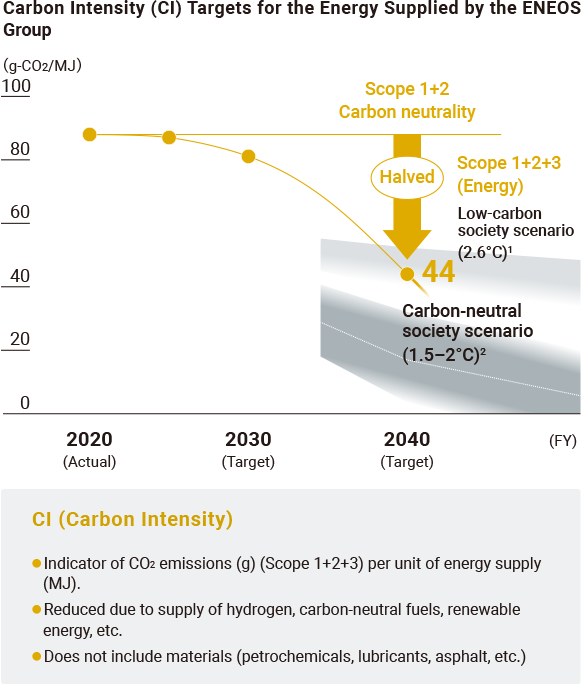
- 1ENEOS assumptions referring to IEA STEPS case
- 2ENEOS assumptions referring to IEA APS/NZE case